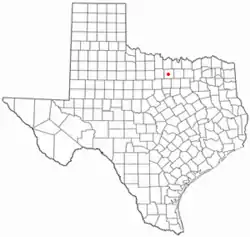Paradise, Texas | |
|---|---|
 Location of Paradise, Texas | |
 | |
| Coordinates: 33°9′1″N 97°41′19″W / 33.15028°N 97.68861°W | |
| Country | United States |
| State | Texas |
| County | Wise |
| Area | |
| • Total | 2.01 sq mi (5.20 km2) |
| • Land | 2.01 sq mi (5.20 km2) |
| • Water | 0.00 sq mi (0.00 km2) |
| Elevation | 758 ft (231 m) |
| Population (2020) | |
| • Total | 475 |
| • Density | 279.66/sq mi (107.97/km2) |
| Time zone | UTC-6 (Central (CST)) |
| • Summer (DST) | UTC-5 (CDT) |
| ZIP code | 76073 |
| Area code | 940 |
| FIPS code | 48-55056[2] |
| GNIS feature ID | 1381237[3] |
Paradise is a city in Wise County, Texas, United States. The population was 475 in 2020.[4]
According to tradition, the area was a cowboy's "paradise", hence the name.[5]
In 1985, Blue Bell Ice Cream filmed a television commercial in Paradise. The commercial starred some residents of the town.
Geography
Paradise is located at 33°9′1″N 97°41′19″W / 33.15028°N 97.68861°W (33.150340, –97.688728). According to the United States Census Bureau, the city has a total area of 2.0 square miles (5.2 km2), all land.[6]
Demographics
| Census | Pop. | Note | %± |
|---|---|---|---|
| 2000 | 459 | — | |
| 2010 | 441 | −3.9% | |
| 2019 (est.) | 561 | [7] | 27.2% |
| U.S. Decennial Census[8] | |||
| Race | Number | Percentage |
|---|---|---|
| White (NH) | 398 | 83.79% |
| Black or African American (NH) | 4 | 0.84% |
| Native American or Alaska Native (NH) | 2 | 0.42% |
| Asian (NH) | 2 | 0.42% |
| Some Other Race (NH) | 1 | 0.21% |
| Mixed/Multi-Racial (NH) | 15 | 3.16% |
| Hispanic or Latino | 53 | 11.16% |
| Total | 475 |
As of the 2020 United States census, there were 475 people, 190 households, and 125 families residing in the city.
Education
The City of Paradise is served by the Paradise Independent School District.
References
- ↑ "2019 U.S. Gazetteer Files". United States Census Bureau. Retrieved August 7, 2020.
- ↑ "U.S. Census website". United States Census Bureau. Retrieved January 31, 2008.
- ↑ "US Board on Geographic Names". United States Geological Survey. October 25, 2007. Retrieved January 31, 2008.
- 1 2 "Explore Census Data". data.census.gov. Retrieved May 21, 2022.
- ↑ Moyer, Armond; Moyer, Winifred (1958). The origins of unusual place-names. Keystone Pub. Associates. p. 98.
- ↑ "US Gazetteer Files 2016-Places-Texas". US Census. Retrieved January 7, 2017.
- ↑ "Population and Housing Unit Estimates". United States Census Bureau. May 24, 2020. Retrieved May 27, 2020.
- ↑ "Census of Population and Housing". Census.gov. Retrieved June 4, 2015.
- ↑ https://www.census.gov/
- ↑ "About the Hispanic Population and its Origin". www.census.gov. Retrieved May 18, 2022.
External links
This article is issued from Wikipedia. The text is licensed under Creative Commons - Attribution - Sharealike. Additional terms may apply for the media files.
